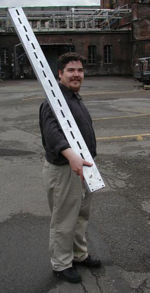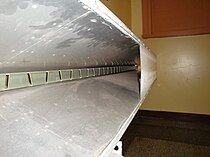Slot antenna


A slot antenna consists of a metal surface, usually a flat plate, with one or more holes or slots cut out. A slotted waveguide is a waveguide that is used as an antenna in microwave radar applications. When the plate is driven as an antenna by a driving frequency, the slot radiates electromagnetic waves in a way similar to a dipole antenna. The shape and size of the slot, as well as the driving frequency, determine the radiation pattern. Often the radio waves are provided by a waveguide, and the antenna consists of slots in the waveguide. Slot antennas are usually used at UHF and microwave frequencies, where the waves are usually conducted by waveguide, so a slot in the waveguide makes a simple antenna. They are often found in standard desktop microwave sources used for research purposes. A slot antenna's main advantages are its size, design simplicity, and convenient adaptation to mass production using either waveguide or PC board technology.
Structure
An antenna consisting of multiple parallel slots in a waveguide is a widely used array antenna which radiates a narrow fan-shaped beam of microwaves at right angles to the waveguide, with its narrow axis in the plane of the waveguide and its wide axis perpendicular to the waveguide. Multiple slot versions are widely used in radar antennas, particularly marine radar antennas on ships, and for the sector antennas used for cell phone base stations.
Due to Babinet's principle a slot in a waveguide has the same radiation pattern as a driven rod antenna whose rod is the same shape as the slot. This can be used to determine the radiation pattern using calculations for a more conventional antenna.
Usually a slotted waveguide antenna is protected by microwave transparent material, which may visually obscure the slots. Nevertheless, it is easily distinguished from a parabolic reflector by its flat or tube shape. The wave guide contains slits with size of about 1/4 wavelength, in a distance of 1/2 wavelength.
History
The slot antenna was invented in 1938 by Alan Blumlein, while working for EMI. He invented it in order to produce a practical type of antenna for VHF television broadcasting that would have horizontal polarization, an omnidirectional horizontal radiation pattern and a narrow vertical radiation pattern.[1][2]
Prior to its use in surface search radar, such systems used a parabolic segment reflector. The slotted waveguide antenna was the result of collaborative radar research carried on by McGill University and the National Research Council of Canada during World War II.[3] The co-inventors, W.H. Watson and E.W. Guptill of McGill, were granted a United States patent for the device, described as a "directive antenna for microwaves", in 1951.[4]
Similar technologies
For comparison, in the parabolic type of antenna a feedhorn at the end of a waveguide directs a conical beam of output energy toward the reflector, whence it is focused into a narrow collimated beam. Reflected energy from the environment follows the reverse path and is focused by the reflector onto the feed horn where it travels back to the receiver. The reflector must be built to a precision determined by the wavelength used. For a one centimeter wavelength, a reflector precision of one or two millimeters would be adequate.

A slotted waveguide has no reflector but emits directly through the slots. The spacing of the slots is critical and is a multiple of the wavelength used for transmission and reception. The effect of this geometry is to form a high gain antenna that is highly directional in the plane of the antenna. Without augmentation a slotted waveguide is not as efficient as a parabolic reflector, lacking an ability to focus in the vertical plane, but is much more durable and is less expensive to construct. The antenna's vertical focus is usually enhanced by the application of a microwave lens attached to the front of the antenna. As this, like the companion slotted waveguide, is a one-dimensional device, it too may be made relatively cheaply as compared to a parabolic reflector and feedhorn.
Other uses
In a related application, so-called leaky waveguides are also used in the determination of railcar positions in certain rapid transit applications. They are used primarily to determine the precise position of the train when it is being brought to a halt at a station, so that the doorway positions will align correctly with queuing points on the platform or with a second set of safety doors should such be provided.
See also
- Slotted waveguide
- Microwave Radiometer (Juno) (has a slot array antenna)
- RIMFAX (radar for Mars rover has slot antenna design)
References
- ^ Blumlein, Alan (1938-03-07), "Improvements in or relating to high frequency electrical conductors or radiators", British patent no. 515684
- ^ Burns, Russell (2000). The life and times of A.D. Blumlein. Institution of Engineering and Technology. ISBN 0-85296-773-X.
- ^ Covington, Arthur E. (1991). "Some recollections of th radio and electrical engineering division of the National Research Council of Canada, 1946-1977". Scientia Canadensis: Canadian Journal of the hIstory of Science, Technology and Medicine. 15 (2): 155–175.
- ^ Watson, William Heriot; Guptill, Ernest Wilmot (6 November 1951), Directive Antenna for Microwaves, retrieved 20 December 2016
External links
- "Slot Antennas". Antenna Theory.
- Slotted Waveguide Antennas Antenna-Theory.com



